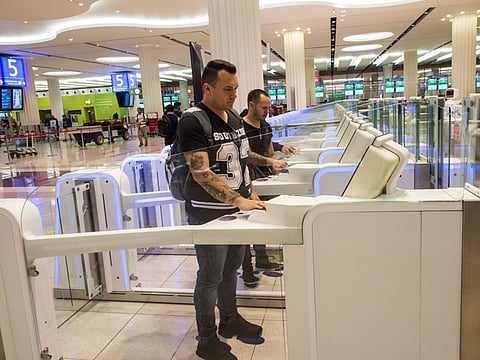DXB to invest more in AI, facial recognition for 120 million passenger target, says Dubai Airports CEO
Dubai International will eventually turn into a real estate masterplan: Paul Griffiths

Dubai: Dubai International (DXB) is investing heavily in advanced technology, including Artificial Intelligence (AI) and facial recognition technology, as a core strategy to make the passenger journey more seamless and expand capacity until the world's busiest hub reaches 120 million passengers. According to Dubai Airport CEO Paul Griffiths, all operations can be moved to the new proposed passenger terminal at Al Maktoum International Airport (DWC) by this time.
Following this, Griffiths said the existing Dubai International Airport would be closed down and turned into a new real estate masterplan. He said, "I rather think that as we get towards DWC's full scale of operations, the focus will shift there, DXB will close and we'll redevelop the area. It will spread the city out."
“As far as a timeline for DXB, we’re talking quite a long time in the future. I’m sure there are a number of real estate developers excited to get their hands on it for redevelopment. I can’t really give [an] indication until we get there," added Griffiths.
He said the focus on technology, processes, and people has been crucial, particularly as DXB has not opened major new infrastructure in the last decade.
Dubai welcomed 92 million passengers in 2024 and is forecast to serve 96 million by the end of 2025. “I am confident that we are going to hit the 100 million for the end of 2026,” Griffiths told Gulf News on the sidelines of Arabian Travel Market.
This investment in AI and face recognition tech enables the airport to "eke out that last bit of capacity" and keep traffic flowing efficiently. This efficiency is particularly crucial because, without the space to build major new infrastructure and have not opened any for the past 10 years, the ability to "keep capacity flowing" is paramount. The increases in capacity achieved through these measures provide confidence that DXB could potentially handle up to "120 million" passengers,” explained Griffiths
Looking further ahead, it is anticipated that once DXB reaches this capacity level, services will "gradually... have to move some services away to DWC" (Al Maktoum International). The estimated timeline for this transition is "around 10 years."
Griffiths was critical of traditional airport processes seen elsewhere, stating it's "quite shameful in this era of high tech that more airports are not actually deploying processes that are seamless and invisible." His vision for DXB's passenger journey is to move away from multiple, intrusive steps like check-in, security, document checks, immigration, and customs.
"My vision of the future is one process that you don't even know is happening, where you've got facial or harm recognition... and we surely consolidate all of those separate functions into a single process," Griffiths explained.
Investments for DXB upkeep
That said, Griffiths said Dubai Airports – the operator of DXB and DWC – are adopting a cautious approach while investing in Dubai International’s enhancement to ensure value over time. “We'll be very careful to ensure that we've got the amortization period right because we don't want to be over-investing,” he said.
He added that despite future plans, maintaining investment in the current airport's products and services is crucial in a highly competitive market.
US travel demand
Despite a backdrop of global economic concerns and trade tensions involving the United States and China, Griffiths highlighted a positive trend in travel demand between the UAE and the US. He said there has also been an increase in capacity on these routes. He said, "We still haven't seen any impacts" on traffic related to the US market so far.
"What we're seeing is an increase in the number and capacity between the US," Griffiths said. "We're seeing more seats being put into the marketplace. So, it would suggest that that market is growing rather than retracting." He described this as "a good thing," particularly "despite all the rhetoric" surrounding the economic situation.
While acknowledging that the long-term effects of issues like tariffs remain uncertain and will take time to materialize fully, Griffiths highlighted the potential for Dubai and the wider Middle East region. He suggested that travellers may seek alternatives if they lose confidence in journeys to other destinations, including the US. Dubai's growing reputation positions the Middle East as a potential top choice in such scenarios.
Griffiths also pointed to the inherent resilience of Dubai International's vast network, which connects Dubai to many countries and cities. This diversity provides a buffer, as "if there's a slowdown in one market, it's usually compensated by an increase in demand in other markets," helping the hub navigate potential economic fluctuations.
Sign up for the Daily Briefing
Get the latest news and updates straight to your inbox







